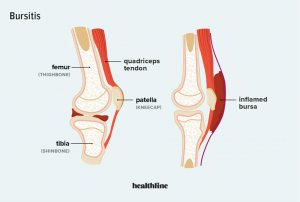What is Bursitis?
Bursitis is inflammation of a bursa. A bursa is a closed, fluid-filled sac that works as a cushion and gliding surface to reduce friction between tissues of the body.
The most common locations for bursitis are in the shoulder, elbow and hip. But you can also have bursitis by your knee, heel and the base of your big toe. Bursitis often occurs near joints that perform frequent repetitive motion
Bursitis is usually a temporary condition. It may limit motion, but generally does not cause deformity.
Causes
The most common causes of bursitis are repetitive motions or positions that put pressure on the bursae around a joint. Examples include:
- Throwing a ball or lifting something over your head repeatedly
- Leaning on your elbows for long periods
- Extensive kneeling for tasks such as laying carpet or scrubbing floors
Other causes include injury or trauma to the affected area, inflammatory arthritis such as rheumatoid arthritis, gout and infection.
Symptoms
The following are the most common symptoms of bursitis. However, each person may experience symptoms differently.
- Pain
- Localized tenderness
- Limited motion
- Swelling and redness if the inflamed bursa is close to the surface of the skin
Chronic bursitis may involve repeated attacks of pain, swelling, and tenderness. These may lead to the deterioration of muscles and a limited range of motion in the affected joint. The symptoms of bursitis may resemble other medical conditions or problems. Always see a healthcare provider for a diagnosis.
Diagnosis
In addition to a complete medical history and physical exam, diagnostic tests for bursitis may include:
- X-ray.
- (MRI).
- Ultrasound.
- Aspiration.
- Blood tests.
Treatment
The treatment of any bursitis depends on whether or not it involves infection.
Aseptic bursitis: This inflammation results from local soft-tissue trauma or strain injury. The bursa is not infected. Treatment may include:
- R.I.C.E. This stands for rest, ice, compression, and elevation
- Anti-inflammatory and pain medicines, such as ibuprofen or aspirin
- Injection of a steroid into the affected area to help decrease pain and swelling
- Splints or braces to limit movement of the affected joint
Septic bursitis: The bursa becomes infected with bacteria. This causes pain and swelling. Treatment may include:
- Antibiotics
- Repeated aspiration of the infected fluid (a needle is used to take out the fluid)
- Surgical drainage and removal of the infected bursa. This is called a bursectomy.
Risk Factors
Anyone can develop bursitis, but certain factors can increase your risk:
- Age. Bursitis becomes more common with aging.
- Occupations or hobbies. If your work or hobby requires repetitive motion or pressure on particular bursae, your risk of developing bursitis increases. Examples include carpet laying, tile setting, gardening, painting and playing a musical instrument.
- Other medical conditions. Certain systemic diseases and conditions — such as rheumatoid arthritis, gout and diabetes — increase your risk of developing bursitis. Being overweight can increase your risk of developing hip and knee bursitis.
Managing Bursitis with Exercise
Treatment for bursitis usually involves doing specific strengthening and stretching exercises for the surround musculature. This helps to reduce the tension within the joint, while assisting to stabilise joint, reducing inflammation. This also helps prevent muscle atrophy. You should avoid activities that cause pain. Ask your Exercise Physiologist about an individualised exercise prescription to help build strength in the area.




